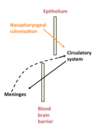Lecture 8 - Meningitis Flashcards
(23 cards)
Why is the brain so sensitive to inflammation?
There isn’t much additional space within the skull, and so when inflammation occurs the intra-cranial pressure increases sharply, which can cause herniation through foramen magnum, or depression of respiratory/cardiac centres. This causes decreased blood supply to the brain, ultimately leading to ischaemia, and then hypoxia
How are clinical disease of infections classified?
Site of infection, infecting organism, host response
Also further classified as acute, subacute or chronic
What infectious pathogens can cause meningitis?
Bacteria, viruses, fungi
What non-infectious things can cause meningitis?
Lymphoma, leukaemia, subarachnoid haemorrhage
What are the routes of infection for meningitis?
Meningitis can be caused by haematogenous spread (usually arterial, but can be via retrograde through veins)
Direct inoculation by either trauma, or can be iatrogenic (neurosurgery, lumbar puncture)
Contiguous spread - where a local infection has spread to meninges (e.g. sinusitis, teeth)
Or viruses can spread from the PNS into the CNS (e.g. herpes, rabies)
What is meningitis?
Meningitis is inflammation/irritation of the meninges and CSF
What are the layers of meninges surrounding the CNS?
Dura mater (outer layer)
Arachnoid mater
Subarachnoid space between arachnoid mater and pia mater, contains CSF
Pia mater
Do organisms reside in normal CSF?
No, CSF is suppose to be sterile
What are the 3 classifications for meningitis?
Acute - Acute meningitis is usually purulent and pyogenic, with many bacteria in the CSF. They’re usually commensal bacteria (respiratory, intestinal, genitourinary)The bacteria evade immune system using their capsules.
Aseptic - Aseptic meningitis is usually caused by viruses, and is usually mild and self limiting. Much less severe than acute meningitis. 80% of aseptic meningitis is caused by enteroviruses. There are increased lymphocytes in CSF.
Chronic - Chronic meningitis can be caused by bacteria, such as in TB or syphillis. It can also be fungal, where the pathogen is cryptococcus neoformans. And there is increased lymphocytes in the CSF.
What is the aetiology of meningitis?
Can be caused by bacteria, which are most often respiratory commensals (neisseria meningitidis, strep. pneumoniae, haemophilus influenzae) The bacteria can also come from trauma/surgery (staph. aureus, streps, gram -ves)
What are the symptoms for meningitis?
Fever (>39C)
Neck stiffness (mainly in saggital plane)
Photophobia
Lethargy, vomiting, diarrhoea, arthalgia, myalgia, malaise
Neurological effects - Altered mental state (seizures, headache) Skin rash
Papilloedema (optic disc swelling)
What is the classic triad for meningitis?
Neck stiffness, fever, headache BUT triad not always present But fever is most common in 95% of cases
What are the symptoms for meningitis in children?
Symptoms in infants for meningitis are often non-specific e.g. episodes of lethargy and irritability, and a high pitched crying Bulging of the fontanelles is another important symptom
What organisms are most likely to cause meningitis in neonates, who have an immature immune system?
E. coli
Step. agalactiae
Listeria monocytogenes
Herpes simplex virus
Occurs in a neonate due to an immature immune system
What organisms are most likely to cause meningitis in infants <2months old?
Strep. agalatiae, E. coli, Listeria monocytogenes Occurs in an infant <2months due to 3 main causes
- Colonised at birth with the bacteria
- Cross-infection between babies
- Cross-infection between adults
What organisms are most likely to cause meningitis in infants ages 2months - 10 years?
Haemophilus infuenzae
Neisseria meningitidis
Strep. pneumoniae
Viruses
What organisms are most likely to cause meningitis in adolescents?
Neisseria meningitidis
Strep. pneumoniae
What organisms are most likely to cause meningitis in Elderly/immunocompromised?
Strep. pneumoniae
Listeria monocytogenes
Gram -ve bacteria eg. E coli
What organisms are most likely to cause meningitis in people with HIV?
Cryptococcus neoformans
Describe Neisseria meningitidis
It’s a gram negative diplococci often found in the neutrophils that have infiltrated the CSF
It’s a respiratory commensal found in 5-15% of people
It uses pili and cell wall opacity proteins (Opa, Opc) to adhere to endothelium, and then uses porins to translocate across the epithelia to enter the blood stream. It uses a capsule to evade the immune system by inhibiting phagocytosis and complement action.
Causes inflammation due to the LOS on surface of capsule.
What is the pathogenesis of meningitis? - How the microbe reach the CSF
Microorganisms can gain entry to the CSF either by crossing the nasopharyngeal epithelium into the blood, or by direct inoculation into the blood, or by haematogenous spread from another site of infection. If the microbe gains entry via the latter two, it must survive long enough in the circulation until it reaches and crosses the blood brain barrier to enter the CSF.
Re-inoculation of the blood stream with the microorganism infecting the meninges can result in sepsis.

How is meningitis diagnosed?
Can take a sample of CSF via lumbar puncture (best taken before antimicrobials given)
The normal CSF is clear and colourless, infected CSF has a yellow/orange/pink colour, and may contain pus
In acute bacterial infection, WBC and proteins are elevated and glucose is decreased
In Aspetic infection, there are increased WBCs and glucose, and increase protein
Can do a gram stain to direct initial microbial therapy, or we can culture the bacteria in the CSF. (howerver, prior antimicrobials decrease sensitivity of gram stain/culture)
We can also use PCR on the bacteria and viruses in the CSF to specify which organism it is
What is the treatment for meningitis?
If a person comes to a GP clinic with suspected meningitis IM penicillin or ceftriaxone must be given then before they go to the hospital.
At the hospital they must be treated empircally first with IV ceftriaxone +/- amoxicillin 5-7 days.
As test results come, the treatment can be modified to that specific organism.
Neisseria meningitidis - IV penicillin or ceftatriaxone 3-5days. Can use Rifampcin to eliminate meningoccal nasal carridge
Penicillin resistant Strep pneumoniae requires IV vancomycin
- Haemophilus influenzae* required IV Ceftatriaxone for minimum of 7 days
- Listeria monocytogenes* requires IV ampicillin or amoxycillin for minimum of 2 weeks


